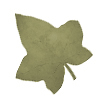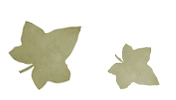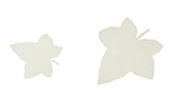|
Genital
Warts; Human Papilloma Virus (HPV)
an article by Susun S. Weed
“I
am the Grandmother of all growth, all growing things,
all life. I am the grandmother of bacteria and viruses
as well as plants and animals, fish and insects.
When you throb with life these other lives live
with you. When your life force ebbs, they live on
you, growing grotesque without the check of your
immunity.
“Do you feel proud of your sexuality my child?
Your immune system thrives on true pride; and fails
when subjected to blame and shame, guilt and mortification.
Walk tall; smile often; be flexible, let life fill
you, and you will have little to fear from most
viruses you meet.”
“… for women who exhibit the earliest
signs of HPV infection, the best prescription may
be no treatment at all,” according to Karyn
Herndon at Northwestern University Medical School
in Chicago. “Three out of four women in the
observation-only group lost their flat warts - a
finding that suggests that the body’s immune
system can drive the virus into a dormant state.”[1]
Women treated with laser removal of cervical warts
were twice as likely as untreated women to have
precancerous and cancerous changes occur in the
following years.
Having an HPV infection is “like having the
sniffles,” says Anna-Barbara Moscicki, MD.
“It’s an infection your body can usually
handle … and get rid of.”[2] In a study
of 600 sexually active women aged 13 to 21, half
became infected with HPV over a 10 year period;
70% of those women did not develop lesions or warts
at all, and only 10% of those who did have lesions
were diagnosed with cervical cancer.[3]
Many of the papilloma viruses are non-contagious,
but some - especially those that give rise to plantar
warts and genital warts (HPV) - are not only contagious,
but widespread and stealthy. They are resilient
enough to live outside the body. Shed skin cells
containing the viruses can remain infectious for
several days in warm, moist places.[4] And symptomless
people can pass HPV to others. Some of the viruses
that cause genital warts are benign; others can
give rise to deadly cancers.
Of the 20 types of HPV which colonize the genital
area, four are known to initiate cervical cancer,
a usually slow-growing cancer which is currently
responsible for the deaths of more women in Africa,
Asia, and India (where Pap smears are not routine)
than any other cancer.[5] Several HPV are implicated
in penile and rectal cancer as well. HPV is the
most common STD in the USA and Europe, with more
than six million new cases a year in the USA.[6]
At least 50%, and probably closer to 100% of all
non-vaccinated sexually-active people will be infected
over their lifetime. During a three-year study,
40% of a group of female college students acquired
HPV infections.[7] Fortunately, only a small percentage
of HPV infections generate cancer, and we can do
much to insure we aren’t in that small percent.
Once infected with human papilloma virus, you are
infected for life. There is no known cure and no
medically-approved treatment. The best strategy
is to nourish the immune system.
Homeopathic Thuja is a “ground remedy”
for the genitals, and is especially indicated when
there are genital warts.[8] Higher dilutions, such
as 30C, are best.
While there is no food that prevents or cures HPV
infections, the likelihood of warts or cancer is
determined by the immune system - which can be nourished
and strengthened with whole grains, well-cooked
greens, roots, cabbage family plants, olive oil,
organic dairy products and meats, onions, garlic,
seaweed, mushrooms, and nourishing herbal infusions
of astragalus, burdock, and nettle.
St. Joan’s wort (Hypericum perforatum) is a
natural antiviral. One of its alkaloids, pseudo-hypericin,
kills HIV. But ingesting it in concentrated form
causes hypersensitivity to sunlight, making it useless
as a drug. Fortunately, the tincture of the fresh
plant - even in large, frequent doses - counters
viruses without triggering sensitivity. Avoid capsules
or teas; they can cause sensitivity. When I feel
the need to prevent a viral infection, I use one
dropperful of Hypericum tincture in a little water
three or four times a day for a few days. When I
want to treat viral infections, I use one or two
dropperfuls in water every hour or two until symptoms
abate, and continue at a lower dose until I no longer
need it.
Lemon balm (Melissa officinalis) and hyssop (Hyssopus
officinalis) are mint family plants with antiviral
constituents which are especially effective as salves.
Celandine (Celadonium majus) juice is the most effective
way I know to remove external genital warts. It
is safe, painless, and easy to use if you live where
evergreen celandine grows - in Europe, in North
America, from Nova Scotia to Georgia and west to
Missouri, throughout Europe, and in waste places
in temperate-zone cities. The fresh sap from leaf
stalks or the root works fastest, and best, but
topical applications of tincture are somewhat effective,
too.
American mandrake (Podophyllum peltatum) is the
acknowledged queen of external genital wart destruction.
This poisonous plant is used in a concentrated form
- Podophyllin - as a topical treatment. Although
plant-based, Podophyllin can cause severe side-effects,
including burns that scar, fatal reactions, and
birth defects or fetal death if used during pregnancy.
To prevent damage to healthy tissues, all skin except
for the warts must be thoroughly covered with petroleum
jelly before it is applied, and the Podophyllin
must be wiped off before it penetrates too deeply,
usually within one to four hours. Weekly treatments
over six or more weeks are the norm. A less concentrated,
and thus safer form - Podofilox - is available by
prescription for use at home. (But trichloroacetic
acid is safer, and celandine is more fun.)
Eastern white cedar, Thuja occidentalis, is the
“tree of life.” Thuja is primarily a homeopathic
remedy, but thuja tincture or essential oil applied
twice a day to genital warts can “burn”
them off.
Trichloroacetic acid is as effective as Podophyllin
in removing warts, but less likely to leave scars
or provoke severe systemic reactions, and is considered
safe to use during pregnancy.[9] It is applied in
the doctor’s office, usually weekly for six
weeks.
Colposcopy is a close examination of the cervix
with magnifying binoculars after it has been bathed
with acetic acid (vinegar), which turns HPV-infected
tissues bright white. You do not have to agree to
a biopsy if you agree to a colposcopy; testing for
HPV-DNA is better in many ways. If you do agree,
biopsy forceps will be used to “chomp”
out pieces of cervical tissue for microscopic examination
by a pathologist.
Testing cervical cells for the presence of DNA from
cancer-causing HPV is “just as effective as
a biopsy of cervical tissue, with less expense,”
according to researchers at Georgetown University
Medical Center in Washington, DC. Screening every
woman over 20 every two years with an HPV-DNA test
would reduce the number of cervical biopsies by
60%, they conclude.[10] A woman who tests negative
for HPV, as 45% of women will, does not need a colposcopy.
If the test if positive for HPV, there’s still
only a 10-20% chance that she will require treatment.[11]
“It is not known how many women who have had
expensive [and painful] laser surgery or …
cryosurgery are informed beforehand that the treatment
is purely cosmetic and has a high recurrence rate.”[12]
Before you agree to any procedure, remember that
removal of infected tissue does not remove the virus,
which remains ready to recur when the immune system
is at an ebb. Surgery doesn’t cure HPV, and
because it is a major stress to the immune system,
it can increase the chances that a given lesion
will progress to cancer.
“Regardless of treatment, one in four HPV-infected
people will have a recurrence within three months.”[13]
[1] “The cervical dilemma: Some warts may
be better left untreated,” Kathy A. Fackelmann,
Science News, 139: 362?3, June 8, 1991
[2] “HPV doesn’t have to spell cancer,”
Christie Aschwanden, Health, Jan/Feb 2002
[3] Ibid
[4] .“Contagion: A sometimes lethal sexual
epidemic that condoms can’t stop,” Jerome
Groopman, New Yorker, September 13, 1999
[5] “Contagion,” Jerome Groopman, New
Yorker, 1999
[6] “FDA licenses new vaccine …,”
FDA news release, June 2006
[7] “Contagion,” Jerome Groopman, New
Yorker, 1999
[8] Natural Healing in Gynecology, Rina Nissim,
Pandora, 1984 (p. 43)
[9] Our Bodies, Ourselves, Boston Women’s Health
Book Collective, 1998
[10] “Adding an HPV,” Cornell Uni. Women’s
Health Advisor, July 2002
[11] “One Way to Avoid Unnecessary Testing
After Ambiguous Pap Results,” HealthFacts,
May 2001
[12] “Screening for Cervical Cancer,”
HealthFacts, XV (136), Sept 1990
[13] PDR Family Guide to Women’s Health, Medical
Economics, 1994
Legal
Disclaimer: This content is not intended
to replace conventional medical treatment. Any suggestions
made and all herbs listed are not intended to diagnose,
treat, cure or prevent any disease, condition or
symptom. Personal directions and use should be provided
by a clinical herbalist or other qualified healthcare
practitioner with a specific formula for you. All
material on this website/email is provided for general
information purposes only and should not be considered
medical advice or consultation. Contact a reputable
healthcare practitioner if you are in need of medical
care. Exercise self-empowerment by seeking a second
opinion.
Susun Weed
PO Box 64
Woodstock,
NY 12498
Fax: 1-845-246-8081
Visit
Susun Weed at: www.susunweed.com and www.ashtreepublishing.com
For permission to reprint this article, contact
: susunweed@herbshealing.com
Vibrant, passionate,
and involved, Susun Weed has garnered an international
reputation for her groundbreaking lectures, teachings,
and writings on health and nutrition. She challenges
conventional medical approaches with humor, insight,
and her vast encyclopedic knowledge of herbal medicine.
Unabashedly pro-woman, her animated and enthusiastic
lectures are engaging and often profoundly provocative.
Susun is one
of America's best-known authorities on herbal medicine
and natural approaches to women's health. Her four
best-selling books are recommended by expert herbalists
and well-known physicians and are used and cherished
by millions of women around the world. Learn more
at www.susunweed.com
This
article is © copyright Susun
S. Weed 2004 - Republished here with kind permission. |
|












